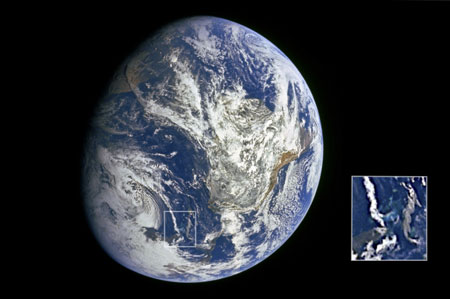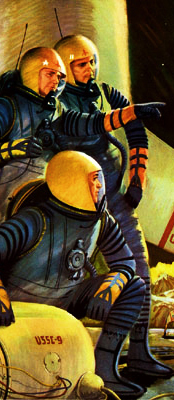
This picture marks a turning point for the human species: It’s the first photo made by a person that shows the entire Earth. It was taken by astronaut Bill Anders on December 21, 1968 from the moon-bound Apollo 8 spacecraft. If you’re having trouble figuring out what you’re looking at, don’t feel alone: Anders was confused, too, at first. You have to turn your head 90 degrees to the left to realize that the landmass to the right of center is South America, with North America above it, hidden by clouds, and the tip of western Africa about to disappear into night. Inside Apollo 8, Anders did something even better: he turned his entire weightless body until the view through the window suddenly became familiar.
When I interviewed Anders in 1987 for A Man on the Moon, I showed him this picture. He drew my attention to a small blue-green patch just off the tip of Florida: The shallow waters of the Bahamas (see inset). Anders called it “a turquoise jewel that you could see all the way to the moon…. It was like it was illuminated, like a piece of opal. And you could see that all the way. And I kept being amazed by that.”
I love that quote, and I made sure to include it in Voices from the Moon. It’s an explorer relating a very human moment during the most extraordinary of experiences. When I think about it, I get that precious feeling that I’m almost there myself. I feel an almost overwhelming sense of gratitude for the amazing recollections of Anders and the other men who went to the moon, and for the chances I’ve had to share those memories with everyone else.



{ 6 comments… read them below or add one }
I’m watching From the Earth to the Moon, for about the 12th time, as I read this post. Guess I’ll have to read Voice from the Moon.
Love your work!
Thanks Lisa! And don’t forget “A Passion for Mars!” 😎
I recently read your book, A Man on the Moon, and it was amazing. Couldn’t put it down. I’m still in awe of what the astronauts experience(d). Thanks for this great photo!
Thanks! Be sure to check out “A Passion for Mars” — it’s all about Mars exploration in both human and scientific terms, with lots of personal experiences of the folks who do Mars missions and advocate for Mars exploration.
Hello Andrew,
Nice Article. It seems like no matter where we go in outer space, the focus is always back to mother earth!
Dan S.
p.s. I know it’s been since 2007, @ Spacefest I in Mesa AZ, but thank you agian for signing my copy of your book, “A Man on the Moon”.
I need to come to #4 and bring “Voices…”, that is Great! Finally, the Astronauts can share more than just a dry description. You begin to get a sense, or feeling from the experience! Thanks agian.
Hello Andrew,
One of my favourite paragraphs in your book ‘A Man On The Moon’ is where Michael Collins is recounting his wonderful photograph of Eagle approaching Columbia:
“I got the the earth coming up behind you–it’s fantastic!” Collins captured the sight on film–Eagle, the moon, and the tiny blue and white world. He would always remember the moment: all of humanity captured in a single photograph, minus only himself, the photographer.
That has always been my favourite photograph since my childhood – I was eleven years old during that historic mission in 1969 – it was an inspiration, and has been a major influence on my thinking ever since – regarding the environment and humanity’s destiny.